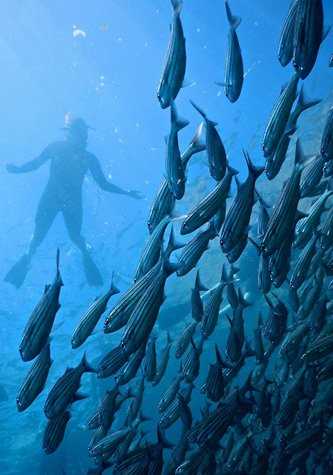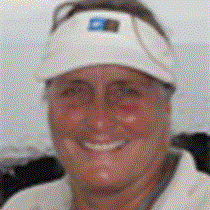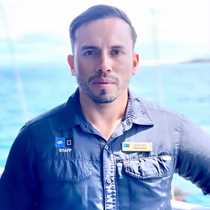I had barely even finished making the early wake-up call on channel one this morning shortly after sunrise when naturalist Greg spotted a small pod of common dolphins leaping and splashing off our starboard bow. Captain Pablo Garces was at the ship’s helm, so he turned east and we followed these beautiful marine mammals for a short distance as they leapt towards the sunrise. Soon however we turned again towards the west and continued along our navigational route viewing as we went, storm petrels and dark-rumped petrels, flying fish, the large triangular fin of a mola mola, and fur seals that were returning to rest on the land after a night of feeding out to sea. It was an absolutely lovely morning and just before hotel manager Daniel called us to come down for breakfast, we found a larger pod of approximately one hundred common dolphins and followed them as they gracefully surfed through the waves, their cream and gray flanks flashing in the morning sun.
After breakfast we all crowded into the bridge and counted down in Spanish with the GPS as we crossed the equator. Bernot, the youngest guest on board this week, blew the ship’s horn and some of us did the limbo under a red, yellow, and blue line (like Ecuador’s flag) that the guides held across the bow deck for us to duck under. Everyone received an “I crossed the equator” pin; we are now all officially “shellbacks.”
An hour later we dropped anchor at the base of the dramatic cliffs of Punta Vicente Roca, Isabela. Isabela is by far the largest island in the Galapagos archipelago, and it is shaped like a seahorse. The crew lowered our fleet of four Zodiacs and we went off to explore the coast. My group counted sea turtles, and we saw our first flightless cormorants. Mario and I, in our Zodiac, had just turned to head back to the ship when I spotted the spout of a whale! We were delighted and called all the other Zodiacs to come and see the whale. We had found a female Bryde’s whale and her small calf! We got a great, close look at the pair when they surfaced near our Zodiac. The Zodiacs followed along with the whales and we especially enjoyed seeing the baby whale splash and flip on its back; its pale belly looked turquoise just under the waves.
We returned to the ship and wiggled into our wet suits, then boarded the Zodiacs and went snorkeling in a calm bay where we found sea turtles swimming and sleeping. There were many fish, of a dozen different varieties, and even some predatory sierra mackerel that darted in to chase small bait fish. Sea lions swam among us and we thoroughly enjoyed the outing!
Following lunch and a needed siesta, naturalist Gaby gave us an excellent talk about the human history of Galapagos, and late in the afternoon we headed in to the coast for a dry landing on the black, barren lava shores of the youngest island of Galapagos, Fernandina. We began the afternoon walk on a pahoehoe lava flow and we were immediately amazed and delighted by the incredible variety of wildlife. Marine iguanas rested everywhere on the rocks and we found several baby ones, too. The ever present and entertaining sea lions nursed their pups and snoozed on the sandy beaches. We saw flightless cormorants drying their feathers in preparation for the chilly night ahead and some of us saw a Galapagos constrictor snake that had an extended belly from a recent meal. Galapagos hawks flew overhead and we saw a pair of black and white oyster catchers with bright red bills and a shrill, loud call. What a day! Everyone has experienced the magic of Galapagos today!









